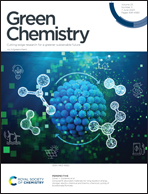Closed-loop utilization of polyester in the textile industry†
Abstract
Abundant and easily accessible waste polyester textiles have high potential for producing new polyethylene terephthalate (PET) materials that could enter the next cycle of textile production. However, the conventional glycolysis strategy that is suitable for the recycling of single PET components is inefficient at recycling polyester waste textiles due to the heterogeneous nature of waste textiles. The main challenges are the decolorization of the waste polyester textiles and the purification of the glycolysis product monomer. In this study, we establish a new closed-loop strategy to use polyester in the textile industry by developing several techniques, including decolorization of waste textiles, glycolysis of decolorized polyester textiles and purification of the bis(hydroxyethylterephthalate) (BHET) product. A wide range of waste polyester textile samples that were randomly picked from the waste bin and contained a library of additives with different colors were recycled to recover BHET with a yield of up to 89.2%, a purity of up to 99.7% and a whiteness (L* value) of up to >99.9. The recovered BHET could be polycondensed to produce new polyester materials that have comparable properties to those of PET derived from petroleum-based BHET. Ethylene glycol used for decolorization, glycolysis and polycondensation could be recovered by distillation. This development enables the circular utilization of polyester resources in the textile industry.



 Please wait while we load your content...
Please wait while we load your content...